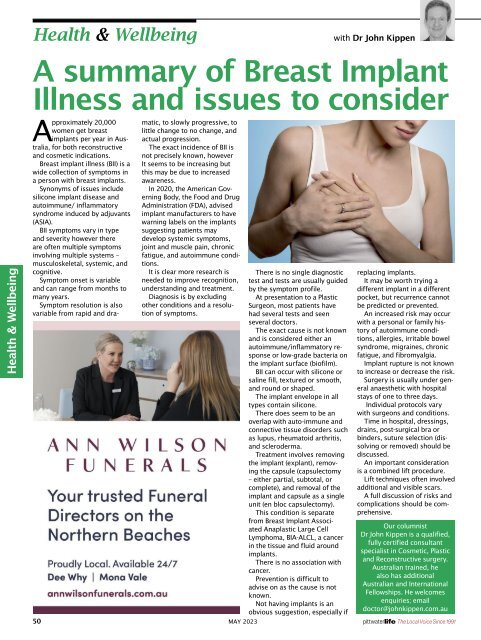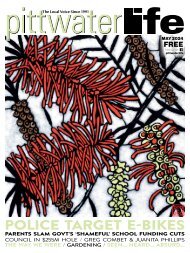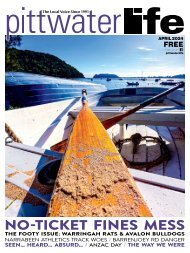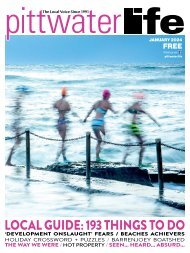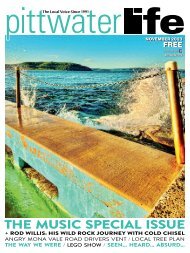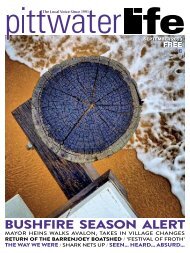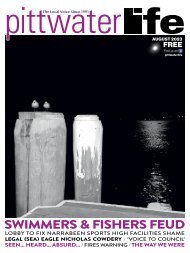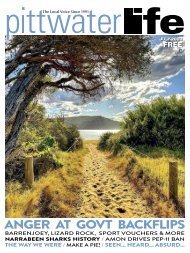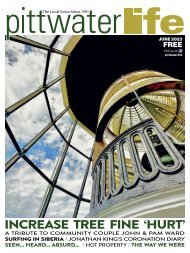Pittwater Life May 2023 Issue
NORTH NARRA PRO SURFING ELECTION WASH-UP: AMON, SCRUBY & REGAN HAVE THEIR SAY MONA VALE AQUATIC RESERVE PUSH / CAROL LANGSFORD THE WAY WE WERE / HOT PROPERTY / SEEN... HEARD... ABSURD...
NORTH NARRA PRO SURFING
ELECTION WASH-UP: AMON, SCRUBY & REGAN HAVE THEIR SAY
MONA VALE AQUATIC RESERVE PUSH / CAROL LANGSFORD
THE WAY WE WERE / HOT PROPERTY / SEEN... HEARD... ABSURD...
Create successful ePaper yourself
Turn your PDF publications into a flip-book with our unique Google optimized e-Paper software.
Health & Wellbeing<br />
with Dr John Kippen<br />
Health & Wellbeing<br />
A summary of Breast Implant<br />
Illness and issues to consider<br />
Approximately 20,000<br />
women get breast<br />
implants per year in Australia,<br />
for both reconstructive<br />
and cosmetic indications.<br />
Breast implant illness (BII) is a<br />
wide collection of symptoms in<br />
a person with breast implants.<br />
Synonyms of issues include<br />
silicone implant disease and<br />
autoimmune/ inflammatory<br />
syndrome induced by adjuvants<br />
(ASIA).<br />
BII symptoms vary in type<br />
and severity however there<br />
are often multiple symptoms<br />
involving multiple systems –<br />
musculoskeletal, systemic, and<br />
cognitive.<br />
Symptom onset is variable<br />
and can range from months to<br />
many years.<br />
Symptom resolution is also<br />
variable from rapid and dra-<br />
matic, to slowly progressive, to<br />
little change to no change, and<br />
actual progression.<br />
The exact incidence of BII is<br />
not precisely known, however<br />
It seems to be increasing but<br />
this may be due to increased<br />
awareness.<br />
In 2020, the American Governing<br />
Body, the Food and Drug<br />
Administration (FDA), advised<br />
implant manufacturers to have<br />
warning labels on the implants<br />
suggesting patients may<br />
develop systemic symptoms,<br />
joint and muscle pain, chronic<br />
fatigue, and autoimmune conditions.<br />
It is clear more research is<br />
needed to improve recognition,<br />
understanding and treatment.<br />
Diagnosis is by excluding<br />
other conditions and a resolution<br />
of symptoms.<br />
There is no single diagnostic<br />
test and tests are usually guided<br />
by the symptom profile.<br />
At presentation to a Plastic<br />
Surgeon, most patients have<br />
had several tests and seen<br />
several doctors.<br />
The exact cause is not known<br />
and is considered either an<br />
autoimmune/inflammatory response<br />
or low-grade bacteria on<br />
the implant surface (biofilm).<br />
BII can occur with silicone or<br />
saline fill, textured or smooth,<br />
and round or shaped.<br />
The implant envelope in all<br />
types contain silicone.<br />
There does seem to be an<br />
overlap with auto-immune and<br />
connective tissue disorders such<br />
as lupus, rheumatoid arthritis,<br />
and scleroderma.<br />
Treatment involves removing<br />
the implant (explant), removing<br />
the capsule (capsulectomy<br />
– either partial, subtotal, or<br />
complete), and removal of the<br />
implant and capsule as a single<br />
unit (en bloc capsulectomy).<br />
This condition is separate<br />
from Breast Implant Associated<br />
Anaplastic Large Cell<br />
Lymphoma, BIA-ALCL, a cancer<br />
in the tissue and fluid around<br />
implants.<br />
There is no association with<br />
cancer.<br />
Prevention is difficult to<br />
advise on as the cause is not<br />
known.<br />
Not having implants is an<br />
obvious suggestion, especially if<br />
replacing implants.<br />
It may be worth trying a<br />
different implant in a different<br />
pocket, but recurrence cannot<br />
be predicted or prevented.<br />
An increased risk may occur<br />
with a personal or family history<br />
of autoimmune conditions,<br />
allergies, irritable bowel<br />
syndrome, migraines, chronic<br />
fatigue, and fibromyalgia.<br />
Implant rupture is not known<br />
to increase or decrease the risk.<br />
Surgery is usually under general<br />
anaesthetic with hospital<br />
stays of one to three days.<br />
Individual protocols vary<br />
with surgeons and conditions.<br />
Time in hospital, dressings,<br />
drains, post-surgical bra or<br />
binders, suture selection (dissolving<br />
or removed) should be<br />
discussed.<br />
An important consideration<br />
is a combined lift procedure.<br />
Lift techniques often involved<br />
additional and visible scars.<br />
A full discussion of risks and<br />
complications should be comprehensive.<br />
Our columnist<br />
Dr John Kippen is a qualified,<br />
fully certified consultant<br />
specialist in Cosmetic, Plastic<br />
and Reconstructive surgery.<br />
Australian trained, he<br />
also has additional<br />
Australian and International<br />
Fellowships. He welcomes<br />
enquiries; email<br />
doctor@johnkippen.com.au<br />
50 MAY <strong>2023</strong><br />
The Local Voice Since 1991


